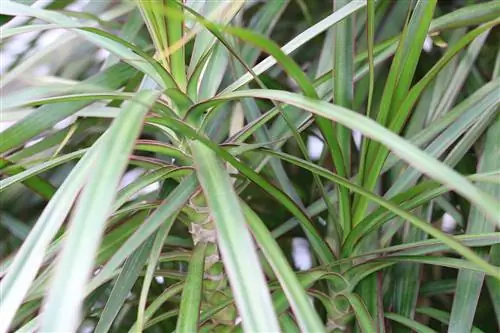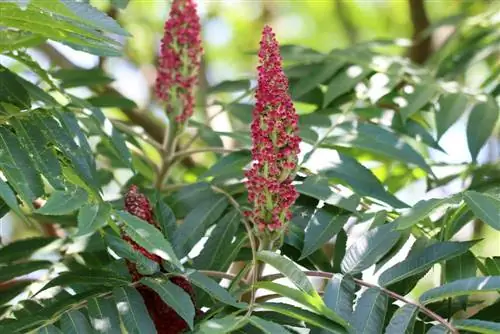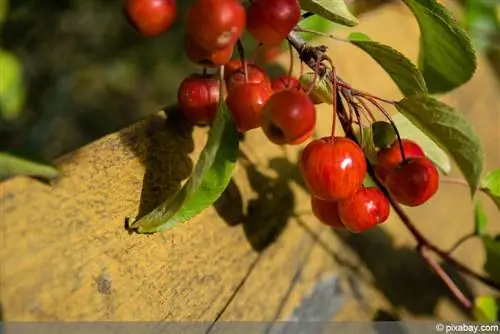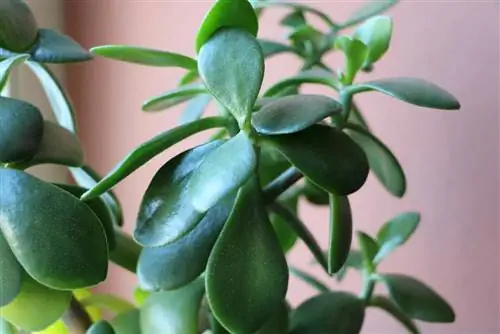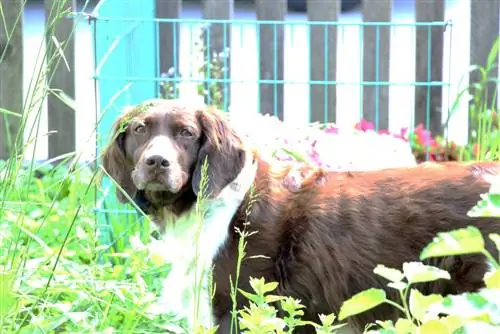- Author admin [email protected].
- Public 2023-12-17 03:39.
- Last modified 2025-01-24 12:45.
One of the shrubs that conjure up a particularly exotic flair in our home gardens is the lotus tree (Clerodendrum trichotomum) from the mint family. In late summer, the pink buds open to reveal pure white star flowers. In autumn, blue-black berries follow, which are framed by wine-red cups and thus provide a second highlight of the year.
Profile
- Botanical name: Clerodendrum trichotomum (Synonym: Clerodendrum fargesii)
- Genus: Lot trees (Clerodendrum)
- Plant family: Mint family (Lamiaceae)
- Common names: lottery tree, lottery tree, Chinese lottery tree, Japanese lottery tree, fate tree
- Origin: Japan, East China
- Growth height: 3 to 6 m
- Leaves: lanceolate, 10 to 20 cm
- Flowers: white with pink or reddish calyx
- Flowering time: from August
- Fruits: bluish with red calyx, slightly poisonous
Location
The Clerodendrum trichotomum, originally from Japan, thrives best in full sun or light partial shade. The shrub, which sheds leaves in cool regions and usually has multiple shoots, requires a lot of space because it can reach a height of almost six meters and a width of three meters when old. The Japanese Losbaum is most beautiful when placed alone in an exposed location.
- Light requirements: full sun or partial shade
- best without direct midday sun
- warm
- protected from icy winds in winter
- facing southeast or west
- in the pot, if possible not on south-facing balconies without shading
- does not tolerate heat accumulation
By the way:
The flowers exude a light vanilla aroma. If you crush the leaves, they smell like peanut butter.
Floor
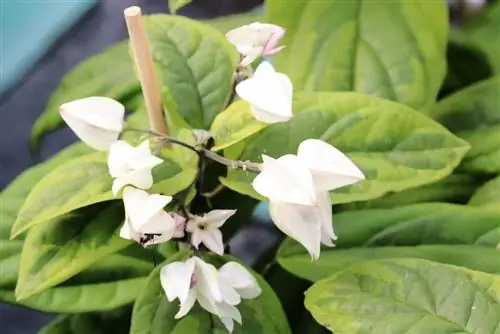
The shrub adapts well to almost all garden soils, whether acidic or alkaline, as long as they are not too wet. The more humus and permeable the substrate is, the easier it is to care for and the more lush the flowers will be.
- humos
- well drained
- slightly moist, but not wet
- profound
- pH value: neutral to slightly acidic
- limetolerant
Plants
In winter hardiness zone 7 (up to -17 degrees) and warmer regions, i.e. almost all areas of Germany, a lottery tree should be planted with similar care as bamboo. Since the tree can spread through root runners, a rhizome barrier may be necessary if the location is not surrounded by a wall, asph alt or concrete paving stones.
- Time: Spring or Autumn
- in cold regions (mountainous regions): only in spring
- deeply loosen up
- if necessary, create a drainage
- Mix in humus or potting soil
- Planting hole: twice the depth and width of the ball
- Planting depth: as before
Planting partner
Clerodendrum trichotomum usually grows up to three meters high as a shrub or small tree. It benefits from similar partner trees or low perennials in its immediate surroundings. If the shrub is on a wall, colorful Persian ivy (Hedera colchicaeine) is an ideal addition. Red-leaved maple species or Chinese tulip trees (Liriodendron chinense) also form a beautiful contrast to the dark green, elongated foliage. An underplanting with ferns or small bamboo species is also very attractive.
Bucket keeping
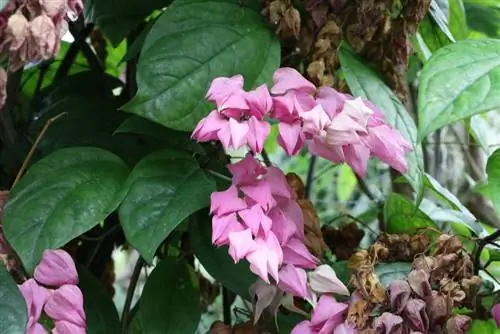
The ornamental shrub is ideal for container cultivation. However, if possible, it should not be placed in a location in the blazing midday sun. It thrives well in a partially shaded spot in a high-quality, humus-rich substrate and requires medium amounts of watering.
Tip:
By the way, the Chinese lottery tree is not only available with dark green leaves. A cultivated form (Variegata) surprises with beautiful, whitish variegated foliage.
Toxicity
The Clerodendrum trichotomum owes its common name, tree of fate, to its slightly poisonous fruits. In this regard, there is little to worry about if the shrub is cultivated individually, as the plant is generally unable to pollinate itself. In addition, the fruits are inedible, so there is little chance of someone accidentally eating large quantities.
Care
In addition to the usual care measures such as watering and fertilizing, it is necessary to regularly remove the root runners of a Japanese loose tree in spring and autumn so that the shrub does not spread uncontrollably in the bed. Otherwise, the ornamental shrub is very robust and absolutely easy to care for.
Pouring
The robust loose tree with its lush foliage of very large leaves requires careful watering so that the tree can grow he althily throughout the season. A dense undergrowth or a thick layer of mulch prevents too much moisture from evaporating from the soil. For potted plants, it is advisable to leave the pot halfway in the soil of the garden bed during periods of heat. This reduces the water requirement enormously, but does not completely eliminate additional watering.
- slightly moist
- the sunnier the location, the more often watering
- never let it dry out completely
- if possible, do not water over flowers and leaves
- does not tolerate waterlogging
Fertilize
During the vegetation phase between spring and late summer, the lotus tree is grateful for an occasional dose of fertilizer.
- Outdoor plants: in spring compost, horn shavings or berry fertilizer
- possibly potash fertilizer in autumn for good winter hardiness
- Potted plants: every 14 days with liquid fertilizer
- alternative: long-term fertilizer for potted plants
- Period: from April to mid-August
Cutting
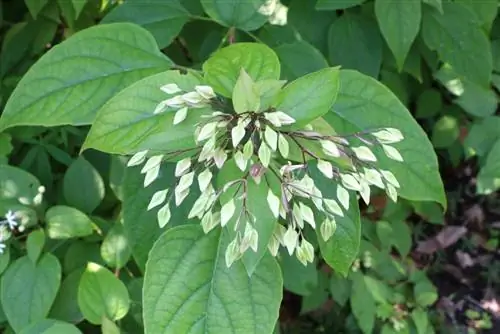
Regular pruning is not necessary for the lotus tree because the shrub grows very slowly. If necessary, older or too large bushes can be cut back in late winter or early spring before new growth appears. It is advisable to incorporate long-term fertilizer into the soil and mulch after cutting. In the spring after frosty winters, be sure to check the shoots for frost damage. A not inconsiderable proportion may die. In addition, a care cut is carried out.
- cut out old, dried or diseased shoots
- cut branches growing inwards at the base
- remove one of two crossing branches
- Cut water shoots (branches growing vertically upwards) at the base
If the crown becomes too large or slowly becomes bald from the inside due to a lack of light, this can also be remedied with a targeted cut. Better than shortening all branches just a little, it is better to cut back individual old or very long branches more. At least two to three eyes or leaf nodes must remain per shoot. To ensure that the crown maintains a beautiful shape, it should always be cut over an outward-facing eye.
Tip:
If you are not sure which branches froze in winter, simply wait until new growth appears before cutting.
Wintering
A Clerodendrum trichotomum is good, but not completely hardy. With temperatures down to -15 degrees in a sheltered spot, a well-established loose tree has few problems. However, at these temperatures there should not be any moisture in the root area. Young plants and seedlings should not overwinter outdoors in the first and second year because they cannot withstand the severe frosts. It is best to place them in a bright or dark place in a cold house. From the third year onwards, the Chinese lottery tree can be planted in a pot or in a bed. In cold regions, additional winter protection is recommended. This is not necessary in wine-growing regions. In mild winters it is possible that the tree even retains its foliage.
- Young plants: at 0 to 5 degrees
- light or dark
- Greenhouse, garage or in the cool basement
- older potted plants: 5 to -10 degrees
- water only enough to prevent the root ball from drying out
- Outdoor plants: pile up mulch, straw or leaves
In very cold areas, it is recommended to pile up the garden soil around the root area to protect the not entirely winter-hardy plant from freezing roots. But wait until the leaves have completely fallen off. If there is frost damage to the shoots, the plant will usually sprout again in spring.
Note:
Alternatively, the Losbaum also offers the option of year-round indoor cultivation. However, you should make sure that it gets enough light in winter and is not right next to the heater.
Propagation
Propagate a Clerodendrum trichotomum is not particularly difficult. The following options are available to choose from:
Seeds
The seeds must be pre-treated before sowing by soaking them in lukewarm water for 24 to 48 hours. You then put them in a plastic bag with moist sand and simulate a cold period of around three months in the vegetable compartment of the refrigerator. Since the tree can only rarely pollinate itself, another plant is usually necessary to harvest seeds.
- Time: Autumn to Winter
- generally under glass at any time
- Substrate: coconut fiber, seed soil or sand-perlite mixture
- Sowing depth: about 1 cm
- Germination temperature: 22 to 25 degrees
- bright, but without direct sunlight
- Germination time: 21 to 60 days
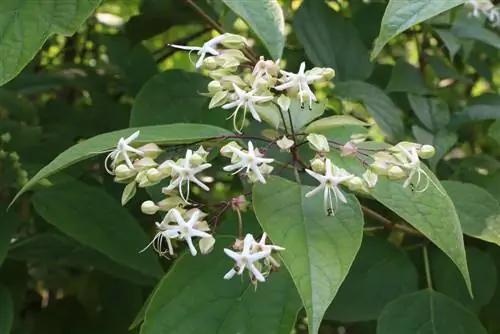
As soon as the seeds germinate, the lid of the mini greenhouse can be removed and the individual plants can be pricked out. The young plants should continue to be watered regularly. In wine-growing regions, planting outdoors can take place as early as spring. In cooler areas, you should wait until the plant is about three years old.
Head cuttings
It is a little easier and less time-consuming to propagate the Japanese lottery tree using cuttings. It is optimal if the fresh shoot tips are already 15 to 20 centimeters long.
- Time: Summer
- only use he althy, strong shoots
- remove lower leaves
- halve very large leaves
- Substrate: clay-sand-humus mixture or potting soil
- Insertion depth: about 5 cm
- pour and keep slightly moist
- Location: bright, without direct sun
Now it's time to wait and water regularly. A clear plastic bag over the cutting prevents rapid evaporation. A sure sign of root formation is the emergence of new leaves. The cover (bag) can be removed and the young plant can be cared for like an older one. The small lottery tree can then be transplanted the following spring.
Root shoots
The third option for propagation is to separate root shoots. This is obtained by carefully digging out the root shoots and cutting out a piece of around five centimeters with a shoot node. Placed about one to two centimeters deep in potting soil and watered, a new plant will form in a cool place until next spring that looks like the mother plant.
Diseases and pests
A lottery tree is very robust and practically free from the common diseases and pests that occur in our latitudes. In an unfavorable location and especially during warm winters, spider mites or whiteflies occasionally appear. In this case, the pests should be thoroughly washed off under the shower or with a garden hose, especially the undersides of the leaves. A cool location with a little more humidity then protects against further spread and new infestation.


